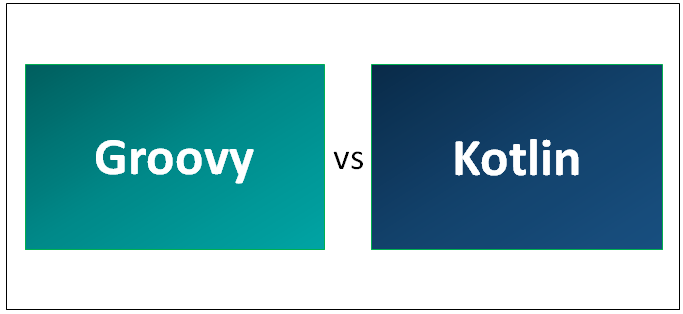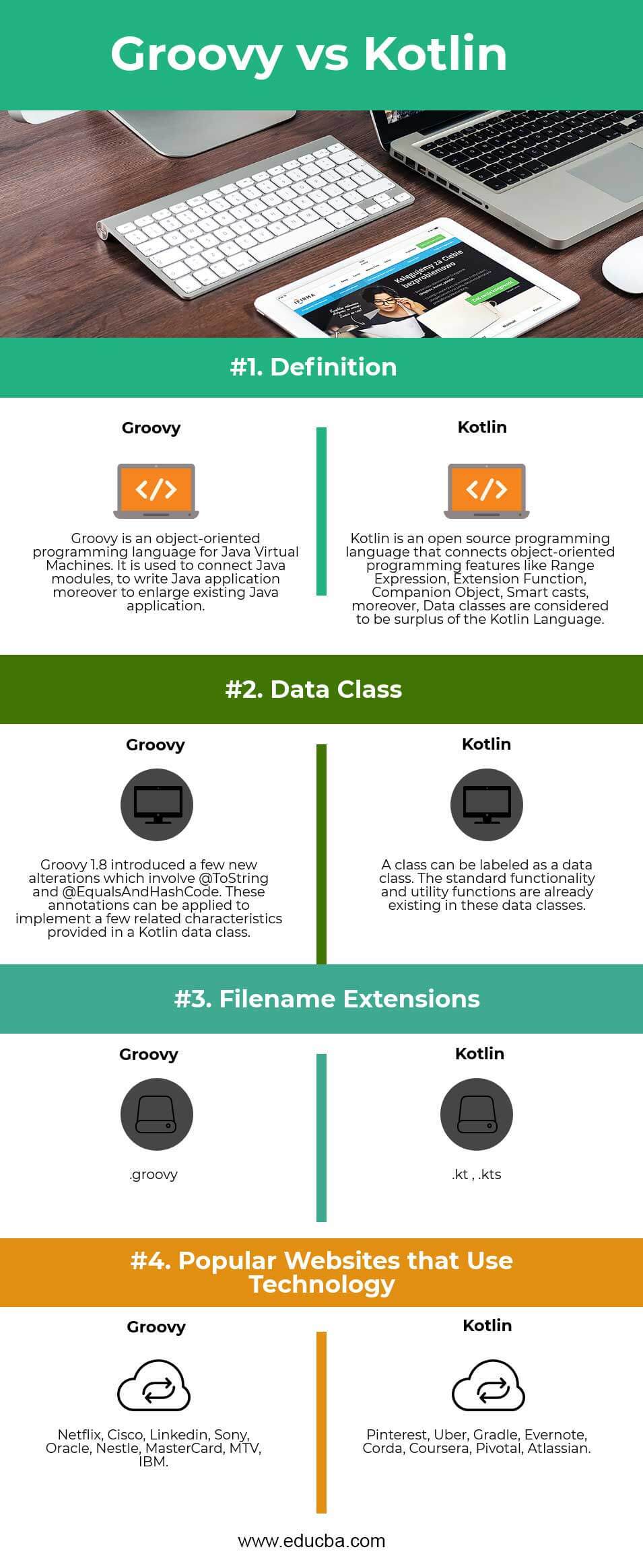Differences Between Groovy vs Kotlin
Groovy is an object-oriented programming language that is based on the Java platform. Groovy 1.0 was released on January 2, 2007, among Groovy 2.4 as the popular, influential release. However, it is distributed through the Apache License v 2.0. It holds both a static and dynamic language, including characteristics related to those of Python, Ruby, Perl and Small talk. It can be used as both a programming language. Moreover, a scripting language for the Java Platform is compiled to J.ava virtual machine (JVM) bytecode, also interoperates seamlessly by different Java code and libraries. Groovy uses a curly-bracket syntax alike to Java’s. Groovy supports closures, multi-line strings, including expressions embedded in strings. Kotlin is a high-level, strongly statically typed programming language introduced by JetBrains, the most intelligent Java IDE’s official designer, named IntelliJ IDEA. Kotlin runs on Java Virtual Machine(JVM). In 2017, Google declared Kotlin is an accepted language for Android development. Kotlin is an open-source programming language that merges object-oriented programming moreover functional characteristics toward a unique platform. The content is classified into several sections that contain associated topics, including manageable, furthermore beneficial examples. Kotlin is the latest open-source programming language similar to Java, Scala, Groovy, Gosu, JavaScript, etc. The syntax of Kotlin may not be specifically related to JAVA; nevertheless, internally, Kotlin is reliant on the present Java Class library to generate excellent outcomes for the developers.
What is Groovy?
Many of Groovy’s strength lies in its AST transformations, triggered by annotations. After version 2, Groovy can be compiled statically, allowing model inference furthermore performance near that of Java. Groovy 2.4 remained the latest significant release following Pivotal Software’s sponsorship which ended in March 2015. Groovy 2.5.2 is the developed durable version of Groovy. Groovy has since improved its governance structure to a Project Management Committee in the Apache Software Foundation. Features of Groovy support both static and dynamic typing, operator overloading, the Native syntax for lists including associative arrays, Native support for regular expressions, and several markup languages such as XML and HTML. Groovy is manageable for Java developers after the syntax for Java and Groovy are quite comparable. You can handle existing Java libraries also possible to extend the java.lang.Object.re
What is Kotlin?
Kotlin gives interoperability, code security, plus accuracy to programmers throughout the world. Kotlin can be compiled to JavaScript source code either handle the LLVM compiler infrastructure. Its fundamental development is of a team of JetBrains developers based in Saint Peters burg, Russia. While the syntax is not cooperative with Java, the JVM implementation of the Kotlin official library is composed to interoperate among Java code also; it is reliant on Java code from the current Java Class Library, such as the models’ framework. Kotlin practices aggressive model inference to decide the type of values plus expressions for which type has been moved unstated. This decreases language wordiness related to Java, which usually necessitates uniquely redundant type specifications prior to version 10. As of Android Studio 3.0 (published in October 2017), Kotlin is entirely maintained by Google for use among their Android operating system; moreover, it is undeviatingly involved in the IDE’s installation package as an option to the standard Java compiler. The Android Kotlin compiler allows the user to decide within targeting Java 6, Java 7, or Java 8-compatible bytecode.
Head To Head Comparison Between Groovy and Kotlin (Infographics)
Below is the top difference between Groovy vs Kotlin
Key Differences Between Groovy and Kotlin
Both are approved choices in the industry. Let us consider some of the notable difference:
- Considering Groovy was created as a dynamic language, also @Compile Static, while a comprehensive annotation, was attached following. Its characteristic seems a little bolted on; moreover, it does not enforce people to code in a static way. It’s not applicable everywhere. However, sometimes even with it on, Groovy appears to have some unique dynamic performance every now and then. Kotlin is 100% Static; furthermore, the dynamic is not an option. Kotlin designed as a statically typed language, including a great type system plus additional statically typed language advantages. Groovy – in the initial position is a dynamically typed language, also simply then – statically.
- Meanwhile, when you allow compiling static in groovy, you get plainly Java. On another side – Kotlin, in their type-system, possess two types of references: nullable and non-nullable, so you can compose code by limited NPEs.
- The next exceptional peculiarity of Kotlin – it doesn’t do any implicit conversions, on the other hands – groovy implicitly convert double to big decimal and so on.
- Although Kotlin has a lot of other characteristics, like smart casts, ADT (doc), type-safe builders, zero-cost abstractions and finally, great IDE support.
- Furthermore, Kotlin type-inference work’s like a charm, without any annotations in every piece of language than Groovy’s.
- Ternary operator: Both, Kotlin vs Groovy provide Elvis operator; however, the ternary operator is missing from the latter.
Groovy vs Kotlin Comparison Table
Below is the topmost comparisons:
| The basis of comparison | Groovy | Kotlin |
| Definition | Groovy is an object-oriented programming language for Java Virtual Machines. It is used to connect Java modules, to write Java application moreover to enlarge existing Java application. | Kotlin is an open-source programming language that connects object-oriented programming features like Range Expression, Extension Function, Companion Object, Smart casts; moreover, Data classes are considered to be a surplus of the Kotlin Language. |
| Data Class | Groovy 1.8 introduced a few new alterations, which involve @ToString and @EqualsAndHashCode. These annotations can be applied to implement a few related characteristics provided in a Kotlin data class. | A class can be labeled as a data class. The standard functionality and utility functions are already existing in these data classes. |
| Filename Extensions | .groovy | .kt , .kts |
| Popular websites that use technology | Netflix, Cisco, LinkedIn, Sony, Oracle, Nestle, MasterCard, MTV, IBM | Pinterest, Uber, Cradle, Ever note, Corda, Coursera, Pivotal, Atlassian. |
Conclusion
Conclusively, it’s a summary of the relationship between Kotlin vs Groovy. The community has a significant impact when it comes to new highlights, and there’s always to assume that a Scala feature will become part of future Java. Notwithstanding their differences, they are total interoperable, which indicates they can co-exist in the same application. Both, Kotlin vs Groovy are JVM languages and are developer-friendly.
Recommended Article
This has been a guide to the top difference between Groovy vs Kotlin. Here we also discuss the Groovy and Kotlin key differences with infographics and comparison table. You may also have a look at the following articles to learn more.


